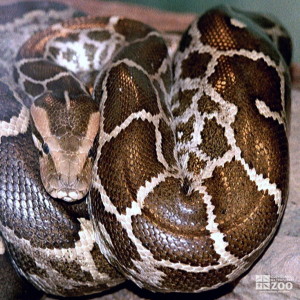Indian Rock Python
[Python molurus molurus]

Indian Rock Pythons commonly reach a length of 8 to 10 feet. Coloration is usually whitish or yellowish with blotched patterns of tan to dark brown depending on their terrain.
Location: Animals Formerly at Zoo
Share:
Range
The range of the Indian Rock Python is India, southern Nepal, Pakistan, Sri Lanka, Bhutan, Bangladesh and north of Myanmar.
Habitat
The Indian Rock Python is found in a wide range of habitats including grasslands, swamps, rocky foothills, marshes, woodlands, open jungles, and river valleys and they rely on a permanent source of water.
Conservation Status
Primary Threats
Gestation
Litter
Over 100 eggs are laid by the Indian Rock Python.
Behavior
Rock pythons are nocturnal, hunting for mice, civets, small deer or birds. During the day they bask in the sun or rest in the shade.
Reproduction
Indian Rock Pythons display a parenting behavior that is very unusual for reptiles, most of which provide no care for eggs or neonates. A female will lay her eggs and then wrap her coils around them. She then incubates them by making a series of muscular contractions all through her body which raises her temperature a few degrees. She does this intermittently during the 80 or so days it takes for the eggs to hatch. Once hatched, the young are on their own.
Wild Diet
Indian Rock Pythons feed on a variety of birds, mammals, and reptiles, but show a particular preference to mammals.
